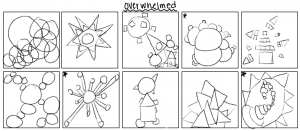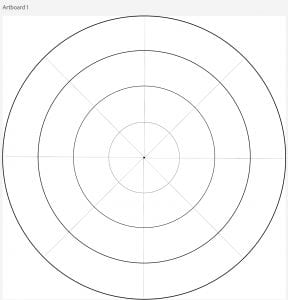...With Color!
Introduction
In the works of this project, we will experiment with translating color into value color applications to illustrate the visual impact through observation, evaluation, and iterations. We are to organize strategies relating to color theory structure and apply it to digital mandalas.
Process
To begin the exploration of color theory, we were given a template to experiment with the use of technology, grayscale, hue, saturation, along with different harmonious ways of working with the way colors can communicate with one another.
When experimenting in this first stage I had come in with intentions that complementary colors were my favorite. I previously liked how when put next to each other they create such a protruding visual effect. I still really enjoy the effect, but I’ve found a new favorite balance of mine to be split complementary. I had no previous knowledge of using this technique, and from this exercise, I found that I really enjoy how it still kind of gives off the effect of complementary but has a little jazz to it.
Within the Procreate app, I began experimenting with more ways of communicating color. I found that I really enjoyed the analogous scheme as well.
Inspiration
For my first color scheme, I wanted to incorporate a princess feel, along with a creepy feel. I took inspiration from some of the tones from the photos as I felt that they worked together to communicate this effect. I decided to do a split-complementary to be able to combine and communicate my ideas.
For my second mandala color scheme, I really liked the idea of incorporating some warm tones into my mandala. When researching colors I found that the colors in these photos worked together to be almost calming and relieving.
I had really liked the idea of the princess, pink tones working together, and so I continued to search for photos that included pink and warm tones. I found this image and noticed it looked similar to an analogous color iteration I had previously explored.
I decided to go with this purple/pink/green split color scheme for my first mandala. I wanted to tie together a pink lighthearted feel with a creepy one, and I felt that these colors worked best with one another. In specific, I enjoyed the purple-green color aesthetic, and how those two colors are associated with toxicity.
For my second mandala color scheme, I decided to choose an analogous idea. I felt that this scheme tied together my idea of the warm tones, and keeping true to the pink aesthetic.
Exploration With Mandalas
1st Mandala
In this first experimentation of incorporating color into my mandala, I decided to place the pink tones in the middlemost area. I had taken inspiration from a tiara to create iterations for this man-made inspired design, and I felt that the pink represented this portion of my design the best. I continued to use this method in all further experiments.
For the middle section, I was currently working with a different grayscale at the time and felt that the purple felt most in place within the diamonds pointing outwards. This section was inspired by the texture of Epcot’s exterior, so I associated the tones to be almost an icy shade of purple.
I also decided to contrast the purple and green against each other on the outermost part of the design. I felt that with these two colors right next to each other, was somewhat what I was envisioning with the purple and green inspiration. I created a gradient effect with shades using a greyscale effect. I wanted the deeper shade to be on the most exterior to lead from a lighthearted pink princess vibe to a darker, more creepy vibe with the eyes.
In this second experimentation, I adjusted the hues I was using. I liked how the green and purple were on the most exterior part, so I decided to keep the concept, but reverse the roles. I also changed the middle section to be purple as well, to help lead into the more eerie side of the design. I was pleased with this design, I felt that this one pertained most to my intentions of creating the design, but I decided not to continue with this one as I was drawn more to the aesthetics of my final experimentation.

In my last experimentation, I decided to combine both of my previous explorations to get this one. A few of the ideas I liked from the two previous explorations was the gradient effect of the green arrows, the purple diamonds and T’s, and the pink center.
With this design, I explored having a colored background and decided to go with a shade of pink. I felt that without this, the greens and the purple took away from the effect I was trying to portray in the center. When doing so I also decided to change the color of the heart pointing outwards. It was originally a lighter shade but lost effect with the background. I decided on a deeper hue to help lead into the more eerie side. I also added purple within the hearts pointing outwards to aid with leading the eye from the pinks to the purples and greens.
One new thing I explored within my final design was adding color to the eyes. I decided to combine the purple and greens to tie in the exterior.
Reflection
As I was deciding between the second and third exploration to choose as my final design, I choose to hear feedback from the last one in a class critique due to me exploring a combination of the first experimentation as well. I was unsure how I exactly felt about it because it stepped away from my original intentions. After hearing feedback from peers, I heard it gave off “Princess-Zombie,” vibes, and I liked that. If someone wouldn’t have pointed that out, I honestly would have gone back to my second exploration, and finished it off.
2nd Mandala
With placing color with the second mandala, I would constantly go back and forth between working on my first one, and this one. I took inspiration from the first one to help modify ideas in this one.
In exploring the color placement of this second mandala, I didn’t have much intention of color placement and explored different aspects.
I first tried switching up the gradient effect, and the color within the diamonds. At the time I was thinking about a thanksgiving aesthetic. Overall I thought this just looked like a mess, and I quickly moved on to another exploration.
Some areas that I did like was the shade of the T’s, somewhat of the center color placement, and also the colors placed within the eyes.
In this second exploration, I decided to only keep the color placement of the T’s. I decided to revert to the concept of the gradient arrows used in the first colored mandala.
I explored keeping the hearts pointing outward the same color as the background to see how it would feel, and also changing the tones within the eyes. I continued to play around with the placements of pink within the center.
I liked how the gradient effect looked on this design, but I strongly disliked the colored background. I felt that this colored background blended everything.

Like my final exploration of my first color scheme, I combined the aspects I liked from both of my first two experimentations. I continued to keep the same tone of the T’s as the first two had, as well as continuing the gradient effect.
I changed the eye color back to the colors from the first and removed the background. When removing the background, I enjoyed the way the center area looked better. Something I didn’t explore in another experimentation was changing the line color of the center part, and keeping the background all the same. I liked how this worked out with these colors and felt that it suited the color scheme.
Reflection
As I didn’t have much set intentions with working with this color scheme, other than having more calm and harmonious energy, I liked how it turned out. I feel that the analogous color scheme help take away from the princess/pink/eye/eerie mood, and bring it all together. I feel that with the specific shapes, the colors should help direct in the direction of both ideas, but the color schemes tie everything together.
Final Reflection
In the process of applying color to my mandala, I felt that my mandala was very flat. This could have been prevented in Project 4 by adding in more layers to create more dimensions, but at the time I was pleased with my work. I feel that this is something that I will pay more attention to in the future to ensure that my work is more enjoyable. I find it helpful to hear back from peers because they all you to see an aspect of your design that you maybe didn’t see. After reviewing and hearing feedback from others it helped direct me into a direction in which I felt more pleased about my decisions on my design.


















































































